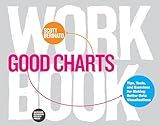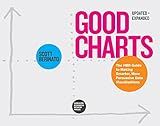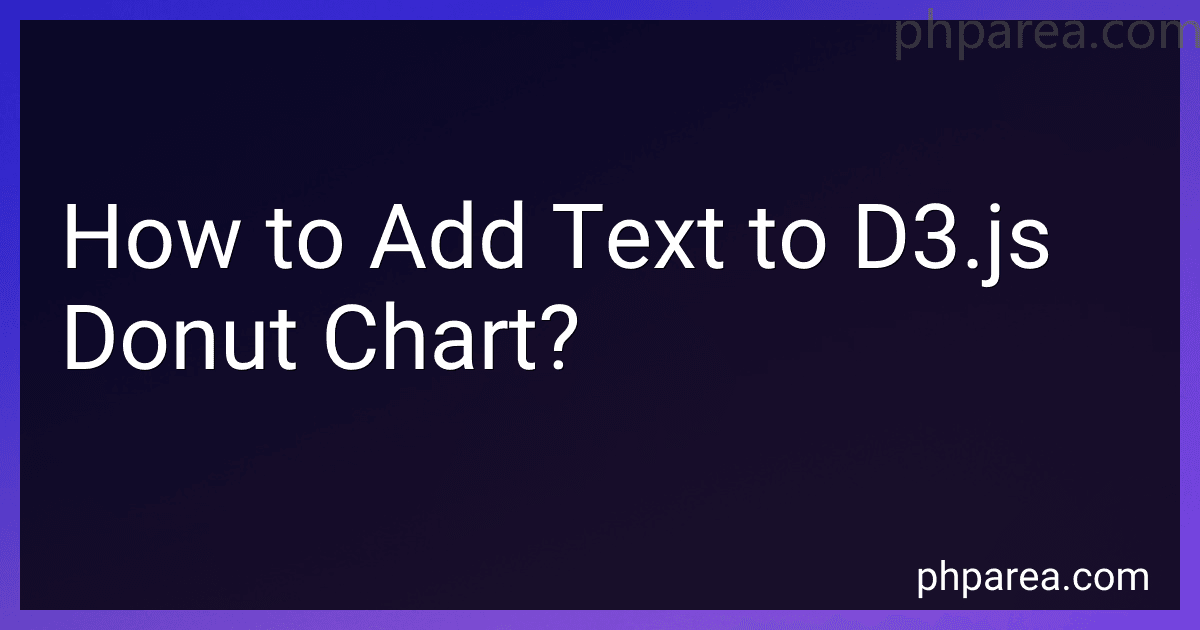Best Data Visualization Tools to Buy in December 2025

Data Visualization with Microsoft Power BI: How to Design Savvy Dashboards



Python Data Science Handbook: Essential Tools for Working with Data



Fundamentals of Data Visualization: A Primer on Making Informative and Compelling Figures



Good Charts Workbook: Tips, Tools, and Exercises for Making Better Data Visualizations



Good Charts, Updated and Expanded: The HBR Guide to Making Smarter, More Persuasive Data Visualizations



Storytelling with Data: A Data Visualization Guide for Business Professionals, 10th Anniversary Edition



Data Visualization with Excel Dashboards and Reports



Data Analytics, Data Visualization & Communicating Data: 3 books in 1: Learn the Processes of Data Analytics and Data Science, Create Engaging Data ... Present Data Effectively (All Things Data)



Interactive Data Visualization for the Web: An Introduction to Designing with D3


To add text to a d3.js donut chart, you can use the "text" method to append text elements to specific positions within the chart. You can adjust the positioning, font size, font family, and color of the text to customize it to your liking. By adding text elements to your donut chart, you can provide additional context or information to your audience and enhance the visual presentation of your data.
How to create a legend using text in a d3.js donut chart?
To create a legend using text in a d3.js donut chart, you can follow these steps:
- Create a container for the legend within your HTML document:
- Define the data for your chart and legend:
var data = [ { category: "Category 1", value: 30 }, { category: "Category 2", value: 50 }, { category: "Category 3", value: 20 } ];
- Create the d3.js donut chart using the data:
var width = 400; var height = 400; var radius = Math.min(width, height) / 2;
var color = d3.scaleOrdinal() .range(["#98abc5", "#8a89a6", "#7b6888"]);
var arc = d3.arc() .innerRadius(radius - 100) .outerRadius(radius - 20);
var pie = d3.pie() .value(function(d) { return d.value; });
var svg = d3.select("#chart") .append("svg") .attr("width", width) .attr("height", height) .append("g") .attr("transform", "translate(" + width / 2 + "," + height / 2 + ")");
var g = svg.selectAll(".arc") .data(pie(data)) .enter().append("g") .attr("class", "arc");
g.append("path") .attr("d", arc) .style("fill", function(d) { return color(d.data.category); });
- Create the legend using text:
var legend = d3.select("#legend") .append("svg") .attr("width", 200) .attr("height", 100) .selectAll("g") .data(data) .enter() .append("g") .attr("transform", function(d, i) { return "translate(0," + i * 20 + ")"; });
legend.append("rect") .attr("width", 18) .attr("height", 18) .style("fill", function(d) { return color(d.category); });
legend.append("text") .attr("x", 24) .attr("y", 9) .attr("dy", ".35em") .text(function(d) { return d.category; });
- Style the legend and chart as needed using CSS.
This code will create a donut chart with a legend displayed as colored rectangles with text labels. You can customize the appearance and layout of the legend and chart by modifying the code and adding additional styles.
How to add a call-to-action using text in a d3.js donut chart?
To add a call-to-action using text in a d3.js donut chart, you can simply append text to the SVG element of the donut chart. Here is an example code snippet that demonstrates how to add a call-to-action using text in a d3.js donut chart:
- First, create the SVG element for the donut chart:
// Set the dimensions and margins of the graph var width = 450 height = 450 margin = 40
// Append the SVG to the body of the page var svg = d3.select("#chart") .append("svg") .attr("width", width) .attr("height", height) .append("g") .attr("transform", "translate(" + width / 2 + "," + height / 2 + ")");
- Then, add the donut chart data and create the donut chart using d3.js:
// Create the data for the donut chart var data = {a: 9, b: 20, c:30, d: 8, e: 12}
// Set the color scale var color = d3.scaleOrdinal() .domain(data) .range(d3.schemeSet2);
// Compute the position of each group on the pie: var pie = d3.pie() .value(function(d) {return d.value; }) var data_ready = pie(d3.entries(data))
// Build the donut chart svg.selectAll('whatever') .data(data_ready) .enter() .append('path') .attr('d', d3.arc() .innerRadius(100) .outerRadius(150) ) .attr('fill', function(d){ return(color(d.data.key)) })
- Finally, add the call-to-action text to the donut chart:
// Add a call-to-action using text svg.append("text") .attr("x", 0) .attr("y", -10) .attr("text-anchor", "middle") .text("Click here to learn more") .style("font-size", "20px") .style("fill", "blue") .on("click", function() { // Add the action you want to take when the text is clicked window.location.href = "https://example.com"; });
This code snippet will add a call-to-action text "Click here to learn more" to the center of the donut chart, and when the text is clicked, it will navigate to the specified URL. You can customize the text and the action to suit your needs.
How to add a title to a d3.js donut chart using text?
To add a title to a d3.js donut chart using text, you can use the following steps:
- Create a SVG element for the chart:
var svg = d3.select("body") .append("svg") .attr("width", width) .attr("height", height) .append("g") .attr("transform", "translate(" + width / 2 + "," + height / 2 + ")");
- Add the title to the SVG element using text:
svg.append("text") .attr("x", 0) .attr("y", -height/2 + 20) .attr("text-anchor", "middle") .style("font-size", "20px") .text("Donut Chart Title");
- Adjust the position and styling of the title as needed by modifying the attributes in the text method.
- Make sure to replace "Donut Chart Title" with the desired title for your chart.
By following these steps, you can easily add a title to your d3.js donut chart using text.
What is the importance of text legibility in a d3.js donut chart?
Text legibility in a d3.js donut chart is important because it ensures that the information being conveyed through the chart is easily readable and understandable for the viewer.
When the text in a donut chart is not legible, it can lead to confusion and misinterpretation of the data being presented. This can hinder the viewer's ability to grasp the key insights and trends that the chart is trying to communicate.
By ensuring text legibility in a donut chart, you are able to enhance the overall user experience and make it easier for viewers to quickly understand and analyze the data. This, in turn, can lead to more effective decision-making and insights derived from the visualizations.
How to align text vertically in a d3.js donut chart?
To align text vertically in a d3.js donut chart, you can use the "dy" attribute in the "text" elements to adjust the vertical position of the text. Here's an example code snippet that demonstrates how you can align text vertically in a d3.js donut chart:
// create SVG element var svg = d3.select("body") .append("svg") .attr("width", 200) .attr("height", 200);
// create donut chart data var data = [10, 20, 30, 40];
// create arc generator var arc = d3.arc() .innerRadius(50) .outerRadius(80);
// create pie layout var pie = d3.pie();
// create arcs var arcs = pie(data);
// append arcs to SVG svg.selectAll("path") .data(arcs) .enter() .append("path") .attr("d", arc) .attr("fill", function(d, i) { return d3.schemeCategory10[i]; });
// add text labels to SVG svg.selectAll("text") .data(arcs) .enter() .append("text") .attr("transform", function(d) { return "translate(" + arc.centroid(d) + ")"; }) .attr("text-anchor", "middle") .attr("dy", ".35em") // adjust vertical position here .text(function(d) { return d.data; });
In the code above, the "dy" attribute is used to adjust the vertical position of the text within the "text" elements. You can experiment with different values for the "dy" attribute to align the text vertically as desired in your d3.js donut chart.
